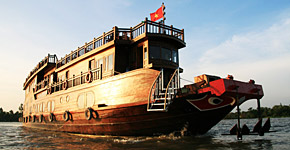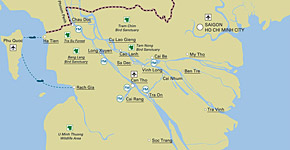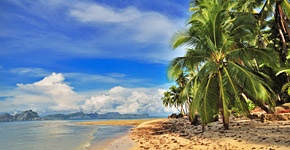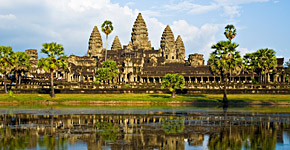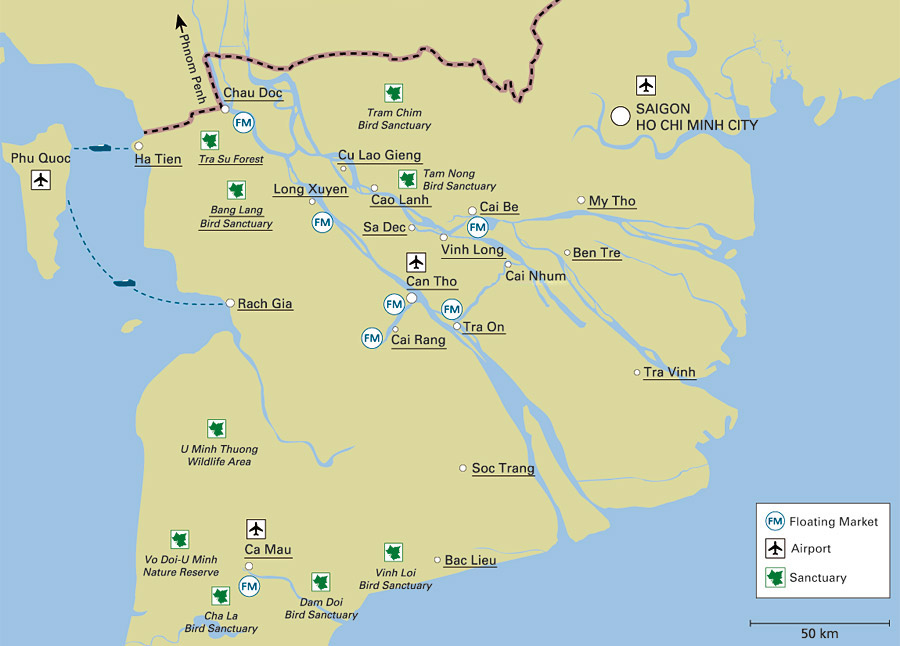Can Tho - Capital of the Mekong delta
Can Tho is by far the largest city in the Mekong delta and also the administrative, economic, industrial and cultural center. The first thing which catches your eye, is the longest suspension bridge in South-East Asia, a symbol of the future. Especially after a few quiet days in the delta Can Tho feels like a metropolis. As the center of politics, commerce, culture and transportation Can Tho is a busy city with a lively waterfront, many winding side streets, great boulevards and a lot of industry. It is also the starting point for those who want to visit the floating markets in the area and want to explore small channels leading out of town with a sampan.
A highlight of the Mekong delta: The floating market in Can Tho
The highlight for most visitors is the floating market of Cai Rang, one of the largest in the Mekong delta, just a few kilometres from the city centre. The best way to explore the market with its overflowing abundance of fruits and vegetables is early in the morning by boat. The Phong Dien floating market is located a little further from Can Tho and is slightly smaller. This market is visited by few tourists and is therefore more authentic.
There is not too much to see in Can Tho itself. The Ong Pagoda is situated near the old market and was founded in 1894 and dedicated to a Chinese general (Quan Kong). The spiritual centre of the Khmer community in Can Tho is the Munirangsayaram Pagoda from 1946. In the Museum of the city you can find some excavations of Oc Eo, an archaeological site in the Mekong delta, which is believed to have been part of the Kingdom of Funan (1st - 7th century AD).
There are some very good restaurants in Can Tho, the most hotels in the Mekong delta are to be found here and also one of the finest hotels of the delta, the Victoria Can Tho, with direct views of the mighty river. Furthermore there is an airport with direct flights to Phu Quoc, Rach Gia, Ho Chi Minh City and Hanoi. There are some markets and shops where travellers can stock up on necessities for their time in the Mekong delta (in other places in the Mekong delta the selection is rather limited or not present).
The city of Can Tho is very dominated by its industrial importance. The Mekong river (Bassac-arm) is very wide and the banks are lined with ever-expanding factories. But for all that there are still corners which have some charm: the large brick factories which look like huge bee hives. Especially when the sky is blue and the black smoke rises from the red domes, it provides a nice contrast. In addition, there are numerous fish farms and their associated fish processing plants. The Bassac arm itself is very busy in this area , lots of big boats operate here. Even sand for construction is raised in this area. The great economic dynamics of the Mekong delta is very clearly visible here.
A more rural area
Despite the industrial development of Can Tho, there are still many small winding canals in the more rural area, which can be discovered with the sampan or by bicycle.
On the peninsula on the north-east end of the town is a large water park. There are also plans for a large entertainment center, for which the construction has already begun.
South of Can Tho, close to Tra On, the Mang Thit canal branches off from the main-arm of the Mekong and connects the Bassac-arm over the Mang Thit river with the northern provinces of Vinh Long and Ben Tre. Since the Mang Thit river meanders strongly here only small ships can travel in this part of the river. This area is a lot more rural. In addition, there are no big industries, so it is a nice contrast to the busy Bassac arm. In this area there are many small side canals and small farms, the landscape is not overly populated and looks pristine and green.
